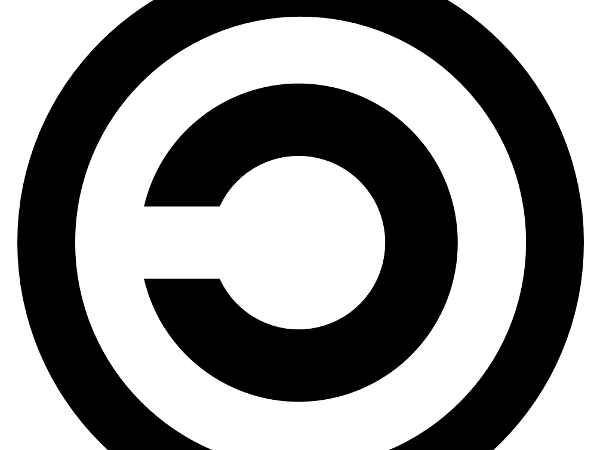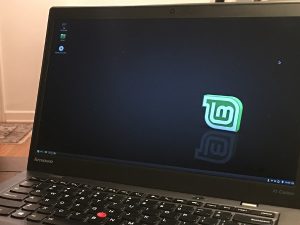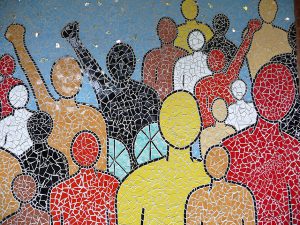Copyleft - introduction

“This song is Copyrighted in the US, and anybody caught singin’ it without our permission, will be mighty good friends of ourn, cause we don’t give a dern. Publish it. Write it. Sing it. Swing to it. Yodel it. We wrote it, that’s all we wanted to do.” – Woody Guthrie
Contents
What is copyleft?
It’s a general term, covering a range of licences that can be applied to different types of creative output, from poetry, photography and music to design specifications and software. The main idea with copyleft is to allow others to do what you’d like them to be able to do with your work – but then, after they’ve used it, copied it, and/or amended it, the conditions in the licence you chose will still apply. So, for example, it will prevent companies from taking the work of others that has been made freely available, changing it a little, and then ‘enclosing’ it by charging for it and preventing it from being used freely.
Copyleft is in the middle of an intellectual property spectrum from public domain at one end to totally copyrighted exclusivity at the other. Copyleft is not a negation of copyright – it’s actually protected by copyright law (copyright encloses the authorship of artistic output – compared to patents, which enclose the invention of methods and tangible things). It uses copyright law to legally enforce the will of the creator of a piece of work, no matter how many times it’s used, passed on and amended. It’s a very effective way to protect the ‘commons’ by using the law, rather than breaking it. The creator is always credited in future iterations of their work.

Richard Stallman, who developed the first copyleft licences in the 1980s – the GNU software licences.
The first copyleft licences were the GNU software licences developed by MIT engineer Richard Stallman in the 1980s. Stallman had amended some software so that others could benefit from his improvements, but found that subsequent versions of similar software had been patented, preventing its further improvement. Stallman worked with a lawyer to design the first copyleft licence, to ensure that he never improved software that was then enclosed and privatised. Here’s Stallman’s GNU Manifesto.
Software was not subject to copyright at all until the mid-1970s, after which time, the corporate world started to patent all the software they developed. This was disparagingly called the ‘Second Enclosure Movement’ (here’s the first one), and was the subject of Michael Heller’s famous 1998 essay The Tragedy of the Anticommons, which concluded that patent rights can prevent useful and affordable things coming to market. This was in opposition to The Tragedy of the Commons, by Garrett Hardin, who claimed that common use of a resource would deplete it (although he wasn’t describing a true commons, which is well-governed by its users).
Wanna Work Together? Simple introduction to Creative Commons.
There are now new software licences to challenge GNU, like Android and Apache – but software developed under these licences can and is patented by tech corporations. This kind of software is championed by the Open Source Movement, whereas truly free (as in freedom) software can’t be enclosed, and is championed by the Free Software Movement. There are huge philosophical differences between the two movements (although of course the code of ‘free’ software is also open-source).
As well as software, copyleft also involves the licensing of non-software creative content, such as images, text etc. A range of ‘share-alike’ licenses has been developed by the Creative Commons – a non-profit organisation founded in 2001.

Creative Commons licence at the bottom of a web page.
There’s also open source hardware, covering the design, documentation and associated software of physical products. The Open Source Hardware Association describes it as: ‘hardware whose design is made publicly available so that anyone can study, modify, distribute, make, and sell the design or hardware based on that design.’
What are the benefits of copyleft?
For many artists, copyright isn’t helpful to them in maximising the number of people they can reach. Copyleft tools are proven to be extremely useful in helping you reach the widest possible audience, whilst keeping the level of control that you want – protecting what you create under your own terms, but allowing others to improve your creation. This helps overall creativity.
However, copyleft isn’t about abolishing copyright – just providing an alternative type of copyright for those who want it.
Copyleft provides the seed for a community of people to work together on a project. You can create a ‘bubble’, and collectively decide its boundaries, so that you can gather people and energy together to work towards the agreed objective. Copyleft can create the space, collectively or individually, where you can work towards a project, and make social agreements on the fate of the project.
Great explanation of non-software copyleft licensing, sitting between full copyright and public domain.
So with copyleft, you set the boundaries of your own commons. You have the freedom to decide what can happen with the fruit of your work. You can protect it. You might want to make it available in the public domain, or you might want to control the destination of your work in other ways. This notion of control, of freedom, and of the flexibility provided by a range of licences, is very important.
Copyleft licences prevent the corporate enclosure (by amending and patenting / copyrighting) of work that the originator wanted to remain open.
What can I do?
Copyright law differs between countries, so it’s a good idea to have a basic understanding of how it works in your country. As mentioned, copyleft is, ironically, protected by copyright law, and so your work should have a copyright notice – the backwards ‘C’ in the main image above has no legal standing, and is only for amusement, and possibly to draw people in (it worked, didn’t it?).
Software
- The GNU General Public Licence (GPL) is the most popular copyleft software licence.
- GitHub’s choosealicense.com is a good way to find a license that fits your needs.
- tl;drLegal has more copyleft licences.

“Knowledge is the common property of mankind.” – Thomas Jefferson.
Other creative work
Go to the Creative Commons website – everything is explained there for beginners. Find the licence that best describes how you would like your work to be used, and the licence will be generated for you, along with an icon, that can be used on your work. For example, you can allow others to copy, amend and sell your work, or you can forbid it – it’s up to you. But whatever you choose will remain with the work in perpetuity.
There are also variants of the Creative Commons licence called ‘Copyfair’ licences, where a distinction can be made between the different types of organisations that might want to use, amend and sell the work. For example, with the ‘peer production’ licence (PPL) the right to commercially gain from the work is restricted to organisations that distribute any surplus generated to their members (for example co-operatives or commons organisations), rather than extract it to pay owners or shareholders.
The inventor of the PPL, Dmytri Kleiner, suggested that it maybe shouldn’t be used for software, however. The reason given was that, although it at first seems attractive to allow small businesses, but not giant corporations, to gain financially from amending and selling your software, if corporations are allowed to do so, but without being able to then privatise and enclose the software, it means that they’ve employed their huge resources to improve the software for small businesses, community enterprises, individuals, co-ops etc. to use. Everyone gains, and corporations pay for it!
Copyrighting all existing melodies to avoid accidental infringement. Damien Riehl gives a TED talk.
If you write music, the work of Damien Riehl and Noah Rubin might interest you. They used artificial intelligence to attempt to write every conceivable melody, using every combination of notes possible, and to put them all into the public domain. Their objective was to end copyright infringement that has been so lucrative for lawyers. It’s about a new way of thinking about creative work, rather than employing armies of lawyers to keep things exclusive.
Business models are changing. The internet has made it extremely difficult and expensive to hang on to intellectual property. The new model is to make everything you produce as available as possible. Get a critical mass of people interested, as quickly as you can – get them to work for free for you to spread the word about you and your work, and to improve your original idea. People who do this successfully, rather than trying to ring-fence the product they’re selling, can make a living from consultancy, books, offers of other work, or even TV appearances – and still sell more of the original product.

Creative Commons licenses have a ‘3-layer’ design – there’s a legal layer to satisfy lawyers; a plain-language layer that’s accessible to the general public; and a ‘machine-readable’ layer that search engines and other tech can understand.
Copyleft is part of the ‘knowledge commons’ – a mode of governance, a set of internal rules for a group of people participating in the creation of something. Remember, absolute openness can leave you exposed to someone else coming along, taking your creation and copyrighting / enclosing it and selling it. So before making something available in the public domain, it might be better to go the legal route of copyrighting it first. If you want to make sure it remains available for everyone, it’s your duty to make sure that you go through the right legal processes.
Consumers – by using copyleft content, you’re accepting the terms and conditions in the licence attached to it; and you always have to acknowledge the original creator of the work.
Specialist(s)
Thanks to Pascal Carpentier for the information.
The specialist(s) below will respond to queries on this topic. Please comment in the box at the bottom of the page.

Pascal Carpentier works in a Swiss not-for-profit developing treatments for neglected populations that do not interest the pharma industry since they don’t represent a market. He’s passionate about Commons and Open Source communities. He hopes his PhD improves understanding of how these alternatives and open ways of production can help to disseminate knowledge, innovations and to craft a fairer world. Favourite quote: “we must follow the one who seeks and flee the one who has already found”.


